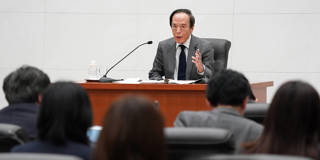The Bank of Japan has consistently sent the message that its monetary-policy normalization will be cautious and data-dependent. This makes it unlikely that the BOJ's policy board will decide to raise interest rates and begin reducing government-bond purchases at the same meeting.
TOKYO – Last month, the Bank of Japan held its benchmark interest rate steady, but signaled that it will soon begin to scale back its government-bond purchases, with the details set to be worked out at the policy board’s July 30-31 meeting. The BOJ promises that markets won’t be blindsided by the pace of the reduction, because policymakers plan to survey market participants about their expectations. But the pace of quantitative tightening (QT) – and how the reduction in purchases will affect bond yields – remains to be seen.

TOKYO – Last month, the Bank of Japan held its benchmark interest rate steady, but signaled that it will soon begin to scale back its government-bond purchases, with the details set to be worked out at the policy board’s July 30-31 meeting. The BOJ promises that markets won’t be blindsided by the pace of the reduction, because policymakers plan to survey market participants about their expectations. But the pace of quantitative tightening (QT) – and how the reduction in purchases will affect bond yields – remains to be seen.